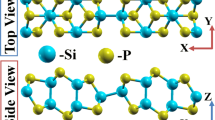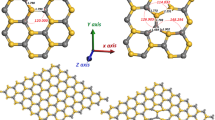Abstract
Using first-principles calculations, we systematically investigate the structures and properties of diamondene-like silicon monolayer (Si4). The Si4 is verified to be dynamically stable by its phonon dispersion spectrum and has a metal characteristics. Once hydrogenating and fluorinating the Si4, moderate indirect bandgaps are obtained in the hydride (Si4H2) and fluoride (Si4F2). Also, the bandgaps of the Si4H2 and Si4F2 can be tuned over a large range via the in-plane tensile strains, even with an indirect-to-direct bandgap transition at a small strain. Besides, the increasing tensile strain can enhance the light-harvesting ability of the Si4H2 and Si4F2 for the near-infrared and visible lights. The exciton binding energy can be significantly reduced with an increased tensile strain, being helpful for the separation of photogenerated electron–hole pairs. These findings extend the applications of the Si4 in optoelectronic devices.
Graphical abstract

Diamondene-like silicon monolayer (Si4) and its hydride (Si4H2) and fluoride (Si4F2)









Similar content being viewed by others
References
Novoselov KS, Geim AK, Morozov SV et al (2004) Electric field effect in atomically thin carbon films. Science 306:666–669
Zhao J, Liu H, Yu Z et al (2016) Rise of silicene: a competitive 2D material. Prog Mater Sci 83:24–151
Zhang K, Feng Y, Wang F et al (2017) Two dimensional hexagonal boron nitride (2D-hBN): synthesis, properties and applications. J Mater Chem C 5:11992–12022
Yi Y, Sun Z, Li J et al (2019) Optical and optoelectronic properties of black phosphorus and recent photonic and optoelectronic applications. Small Methods 3:1900165–1-1900165–19
Yang C, Wang HF, Xu Q (2020) Recent advances in two-dimensional materials for electrochemical energy storage and conversion. Chem Res Chin Univ 36:10–23
Li L, Yu Y, Ye GJ et al (2014) Black phosphorus field-effect transistors. Nat Nanotechnol 9:372–377
Tao L, Cinquanta E, Chiappe D et al (2015) Silicene field-effect transistors operating at room temperature. Nat Nanotechnol 10:227–231
Ahmed S, Yi J (2017) Two-dimensional transition metal dichalcogenides and their charge carrier mobilities in field-Effect transistors. Nano-Micro Lett 9(1):50–1–50–23
Kwak DH, Ra HS, Jeong M-H et al (2018) High-performance photovoltaic effect with electrically balanced charge carriers in black phosphorus and WS2 heterojunction. Adv Mater Interfaces 5:1800671–1-1800671–7
Wang L, Sambur JB (2019) Efficient ultrathin liquid junction photovoltaics based on transition metal dichalcogenides. Nano Lett 19:2960–2967
Kang S, Lee D, Kim J et al (2020) 2D semiconducting materials for electronic and optoelectronic applications: potential and challenge. 2D Mater 7:022003–1–022003–22
Cheng J, Gao L, Li T et al (2020) Two-dimensional black phosphorus nanomaterials: emerging advances in electrochemical energy storage science. Nano-Micro Lett 12:179–1–179–34
Soares DM, Mukherjee S, Singh G (2020) TMDs beyond MoS2 for electrochemical energy storage. Chem Eur J 26:6320–6341
Hussain S, Ullah N, Zhang Y et al (2019) One-step synthesis of unique catalyst Ni9S8@C for excellent MOR performances. Int J Hydrog Energy 44:24525–24533
Hussain S, Yang X, Aslam MK et al (2020) Robust TiN nanoparticles polysulfide anchor for Li–S storage and diffusion pathways using first principle calculations. Chem Eng J 391:123595–1-123595–11
Hussain S, Javed MS, Asim S et al (2020) Novel gravel-like NiMoO4 nanoparticles on carbon cloth for outstanding supercapacitor applications. Ceram Int 46:6406–6412
Vogt P, De Padova P, Quaresima C et al (2012) Silicene: compelling experimental evidence for graphenelike two-dimensional silicon. Phys Rev Lett 108:155501–1-155501–5
Wei W, Jacob T (2013) Strong many-body effects in silicene-based structures. Phys Rev B 88:045203–1-045203–7
Sivek J, Sahin H, Partoens B, Peeters FM (2013) Adsorption and absorption of boron, nitrogen, aluminum, and phosphorus on silicene: stability and electronic and phonon properties. Phys Rev B 87:085444–1-085444–8
Liu CC, Feng W, Yao Y (2011) Quantum spin Hall effect in silicene and two-dimensional germanium. Phys Rev Lett 107:076802–1-076802–4
Molle A, Goldberger J, Houssa M et al (2017) Buckled two-dimensional Xene sheets. Nat Mater 16:163–169
Drummond ND, Zólyomi V, Fal’ko VI, (2012) Electrically tunable band gap in silicene. Phys Rev B 85:075423–1-075423–7
Rachel S, Ezawa M (2014) Giant magnetoresistance and perfect spin filter in silicene, germanene, and stanene. Phys Rev B 89:195303–1-195303–6
Cahangirov S, Topsakal M, Aktürk E et al (2009) Two- and one-dimensional honeycomb structures of silicon and germanium. Phys Rev Lett 102:236804–1-236804–4
Quhe R, Fei R, Liu Q et al (2012) Tunable and sizable band gap in silicene by surface adsorption. Sci Rep 2:853–1–853–6
Shu H, Wang S, Li Y et al (2014) Tunable electronic and optical properties of monolayer silicane under tensile strain: a many-body study. J Chem Phys 141:064707–1-064707–6
Ni Z, Liu Q, Tang K et al (2012) Tunable bandgap in silicene and germanene. Nano Lett 12:113–118
Zhao H (2012) Strain and chirality effects on the mechanical and electronic properties of silicene and silicane under uniaxial tension. Phys Lett A 376:3546–3550
Shu H, Tong Y, Guo J (2017) Novel electronic and optical properties of ultrathin silicene/arsenene heterostructures and electric field effects. Phys Chem Chem Phys 19:10644–10650
Chen X, Jiang J, Liang Q et al (2016) The electronic and optical properties of silicene/g-ZnS heterobilayers: a theoretical study. J Mater Chem C 4:7004–7012
Molle A, Grazianetti C, Tao L et al (2018) Silicene, silicene derivatives, and their device applications. Chem Soc Rev 47:6370–6387
Rui W, Shaofeng W, Xiaozhi W (2014) The formation and electronic properties of hydrogenated bilayer silicene from first-principles. J Appl Phys 116:024303–1-024303–7
Fu H, Zhang J, Ding Z et al (2014) Stacking-dependent electronic structure of bilayer silicene. Appl Phys Lett 104:131904–1-131904–5
Da H, Ding W, Yan X (2017) Magneto-optical manifestation of bilayer silicene. Appl Phys Lett 110:141105–1-141105–5
Liu F, Liu CC, Wu K et al (2013) d+id‘ Chiral superconductivity in bilayer silicene. Phys Rev Lett 111:066804–1-066804–5
Ezawa M (2012) Quasi-topological insulator and trigonal warping in gated bilayer silicene. J Phys Soc Jpn 81:104713–1-104713–8
Qian C, Li Z (2020) Multilayer silicene: structure, electronics, and mechanical property. Comput Mater Sci 172:109354–1-109354–8
Martins LGP, Matos MJS, Paschoal AR et al (2017) Raman evidence for pressure-induced formation of diamondene. Nat Commun 8:96–1–96–9
Gao Y, Cao T, Cellini F et al (2018) Ultrahard carbon film from epitaxial two-layer graphene. Nat Nanotechnol 13:133–138
Bakharev PV, Huang M, Saxena M et al (2020) Chemically induced transformation of chemical vapour deposition grown bilayer graphene into fluorinated single-layer diamond. Nat Nanotechnol 15:59–66
Mu Y (2015) Chemical functionalization of GaN monolayer by adatom adsorption. J Phys Chem C 119:20911–20916
Shu H, Niu X, Ding X, Wang Y (2019) Effects of strain and surface modification on stability, electronic and optical properties of GaN monolayer. Appl Surf Sci 479:475–481
Liu N, Bo G, Liu Y et al (2019) Recent progress on germanene and functionalized germanene: preparation, characterizations, applications, and challenges. Small 15:1805147–1–1805147–11
Rosli NF, Rohaizad N, Sturala J et al (2020) Siloxene, germanane, and methylgermanane: functionalized 2D materials of group 14 for Electrochemical Applications. Adv Funct Mater 30:1910186–1-1910186–11
Ye ZQ, Cao BY (2016) Nanoscale thermal cloaking in graphene via chemical functionalization. Phys Chem Chem Phys 18:32952–32961
Pumera M, Sofer Z (2017) Towards stoichiometric analogues of graphene: graphane, fluorographene, graphol, graphene acid and others. Chem Soc Rev 46:4450–4463
Ding Y, Wang Y (2012) Electronic structures of silicene fluoride and hydride. Appl Phys Lett 100:083102–1-083102–4
Hartman T, Sofer Z (2019) Beyond graphene: chemistry of group 14 graphene analogues: silicene, germanene, and stanene. ACS Nano 13:8566–8576
Giannozzi P, Baroni S, Bonini N et al (2009) QUANTUM ESPRESSO: a modular and open-source software project for quantum simulations of materials. J Phys Condens Matter 21:395502–1-395502–19
Marini A, Hogan C, Grüning M, Varsano D (2009) yambo: an ab initio tool for excited state calculations. Comput Phys Commun 180:1392–1403
Perdew JP, Burke K, Ernzerhof M (1996) Generalized gradient approximation made simple. Phys Rev Lett 77:3865–3868
Baroni S, de Gironcoli S, Dal Corso A, Giannozzi P (2001) Phonons and related crystal properties from density-functional perturbation theory. Rev Mod Phys 73:515–562
Nosé S (1984) A unified formulation of the constant temperature molecular dynamics methods. J Chem Phys 81:511–519
Rohlfing M, Louie SG (2000) Electron-hole excitations and optical spectra from first principles. Phys Rev B 62:4927–4944
Ahuja R, Auluck S, Wills JM et al (1997) Optical properties of graphite from first-principles calculations. Phys Rev B 56:12652–12652
Oschlies A, Godby RW, Needs RJ (1995) GW self-energy calculations of carrier-induced band-gap narrowing in n-type silicon. Phys Rev B 51:1527–1535
Salpeter EE, Bethe HA (1951) A relativistic equation for bound-state problems. Phys Rev 84:1232–1242
Onida G, Reining L, Rubio A (2002) Electronic excitations: density-functional versus many-body Green’s-function approaches. Rev Mod Phys 74:601–659
Spataru CD, Ismail-Beigi S, Benedict LX, Louie SG (2004) Excitonic effects and optical spectra of single-walled carbon nanotubes. Phys Rev Lett 92:077402–1-077402–4
Yang L, Deslippe J, Park C-H et al (2009) Excitonic effects on the optical response of graphene and bilayer graphene. Phys Rev Lett 103:186802–1-186802–4
Zhang Z, Liu X, Yakobson BI, Guo W (2012) Two-dimensional tetragonal TiC monolayer sheet and nanoribbons. J Am Chem Soc 134:19326–19329
Mahata A, Garg P, Rawat KS et al (2017) A free-standing platinum monolayer as an efficient and selective catalyst for the oxygen reduction reaction. J Mater Chem A 5:5303–5313
Yang S, Qin Y, Chen B et al (2017) Novel surface molecular functionalization route to enhance environmental stability of tellurium-containing 2D layers. ACS Appl Mater Interfaces 9:44625–44631
Ryder CR, Wood JD, Wells SA et al (2016) Covalent functionalization and passivation of exfoliated black phosphorus via aryl diazonium chemistry. Nat Chem 8:597–602
Jiang S, Butler S, Bianco E et al (2014) Improving the stability and optical properties of germanane via one-step covalent methyl-termination. Nat Commun 5:3389–1–3389–6
Bissett MA, Tsuji M, Ago H (2014) Strain engineering the properties of graphene and other two-dimensional crystals. Phys Chem Chem Phys 16:11124–11138
Deng S, Sumant AV, Berry V (2018) Strain engineering in two-dimensional nanomaterials beyond graphene. Nano Today 22:14–35
Zhao JZ, Chen LC, Xu B et al (2020) Strain-tunable out-of-plane polarization in two-dimensional materials. Phys Rev B 101:121407–1-121407–5
Annett J, Cross GLW (2016) Self-assembly of graphene ribbons by spontaneous self-tearing and peeling from a substrate. Nature 535:271–275
Pei QX, Sha ZD, Zhang YY, Zhang YW (2014) Effects of temperature and strain rate on the mechanical properties of silicene. J Appl Phys 115:023519–1-023519–6
Pei QX, Zhang YW, Shenoy VB (2010) A molecular dynamics study of the mechanical properties of hydrogen functionalized graphene. Carbon 48:898–904
Sun Y, Liu K (2019) Strain engineering in functional 2-dimensional materials. J Appl Phys 125:082402–1-082402–11
Tran V, Soklaski R, Liang Y, Yang L (2014) Layer-controlled band gap and anisotropic excitons in few-layer black phosphorus. Phys Rev B 89:235319–1–323519
Cheiwchanchamnangij T, Lambrecht WRL (2012) Quasiparticle band structure calculation of monolayer, bilayer, and bulk MoS2. Phys Rev B 85:205302–1-205302–5
Shan W, Little BD, Fischer AJ et al (1996) Binding energy for the intrinsic excitons in wurtzite GaN. Phys Rev B 54:16369–16372
Villegas CEP, Rodin AS, Carvalho A, Rocha AR (2016) Two-dimensional exciton properties in monolayer semiconducting phosphorus allotropes. Phys Chem Chem Phys 18:27829–27836
Shu H, Guo J, Niu X (2019) Electronic, photocatalytic, and optical properties of two-dimensional boron pnictides. J Mater Sci 54:2278–2288https://doi.org/10.1007/s10853-018-2987-8
Cui J, Peng Q, Zhou J, Sun Z (2019) Strain-tunable electronic structures and optical properties of semiconducting MXenes. Nanotechnology 30:345205–1-345205–8
Acknowledgements
This study was funded by Jiangsu University of Science and Technology (No. 1052931610). I thank Dr. Minglei Sun (King Abdullah University of Science and Technology) for providing my help.
Author information
Authors and Affiliations
Corresponding author
Ethics declarations
Conflict of interest
The author declares that they have no competing interest.
Additional information
Handling Editor: Kevin Jones.
Publisher's Note
Springer Nature remains neutral with regard to jurisdictional claims in published maps and institutional affiliations.
Supplementary Information
Below is the link to the electronic supplementary Information.
Rights and permissions
About this article
Cite this article
Shu, H. Tensile strain effects on electronic and optical properties of functionalized diamondene-like Si4. J Mater Sci 56, 5684–5696 (2021). https://doi.org/10.1007/s10853-020-05622-2
Received:
Accepted:
Published:
Issue Date:
DOI: https://doi.org/10.1007/s10853-020-05622-2




